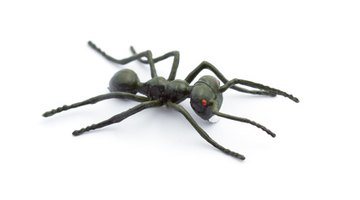Fumigation Risks
For decades, humans have been exposed to the noxious and highly toxic chemicals used to fumigate buildings, soil and produce. Fumigation is a form of pest control that suffocates insects with a gaseous pesticide.

Exported and imported goods are frequently fumigated to prevent the transfer of insects or other exotic organisms.
Pesticide Exposure
Pesticides used in fumigation can persist in the environment, often causing exposure long after the initial application. Chemicals that are sprayed using a high vapor pressure can migrate, exposing nearby persons and property, as well as the person applying the product, to the chemical. Toxic chemicals that are water soluble can leach through the soil and enter the ground water or through runoff may contaminate surface waters. When using pesticides, always follow package instructions and precautions.
Termite Fumigation With Vikane Gas
Vikane (marketed as Dow Agro-Sciences' brand of sulfuryl fluoride) is a chemical product widely used for termite eradication. The chemical is considered a serious health hazard for small children, pregnant women and people with a compromised immune system or suffering from chronic respiratory disease.
Vikane is a dangerous pesticide. Low-level exposure to this deadly chemical can cause throat, nose and lung irritation as well as burning, stinging eyes. Other effects include vomiting, nausea, weakness, slow gait, numbness, irritability and tremors. Chronic exposure observed in fumigant applicators include a buildup of fluid in the lungs, inability to concentrate, slurred speech and seizures.
The Florida Action Network Pesticide Project reports, "There are several reported poisonings in California where people have died after trying to enter a tarped house while it is fumigated, and even one reported death when the house had been approved for re-entry."
Soil Fumigation
Soil fumigant pesticides present a danger to agricultural workers and people who work, live or spend time near fields or gardens that are fumigated. The U.S. Environmental Protection Agency warns, "Health effects may range from mild and reversible eye irritation to more severe and irreversible effects, depending on the fumigant and the level of exposure."
The EPA has implemented safety measures under the Amended Reregistration Eligibility Decisions, also known as REDS, for various fumigants, including methyl bromide, metam sodium/potassium, chloropicrin and dazomet. The EPA provides a complete set of guidelines to reduce the risk of human inhalation of these toxic chemicals.
Requirements include increased agricultural worker protection, buffer zones, emergency preparedness and emergency response plans, as well as restrictions on the application of the chemicals.
The Drip Cap
- For decades, humans have been exposed to the noxious and highly toxic chemicals used to fumigate buildings, soil and produce.
- Chemicals that are sprayed using a high vapor pressure can migrate, exposing nearby persons and property, as well as the person applying the product, to the chemical.
- Vikane (marketed as Dow Agro-Sciences' brand of sulfuryl fluoride) is a chemical product widely used for termite eradication.
- Other effects include vomiting, nausea, weakness, slow gait, numbness, irritability and tremors.
References
Writer Bio
A passionate writer for more than 30 years, Marlene Affeld writes of her love of all things natural. Affeld's passion for the environment inspires her to write informative articles to assist others in living a green lifestyle. She writes for a prominent website as a nature travel writer and contributes articles to other online outlets covering wildlife, travel destinations and the beauty of nature.
Photo Credits
- bug image by dinostock from Fotolia.com
- bug image by dinostock from Fotolia.com
More Articles



